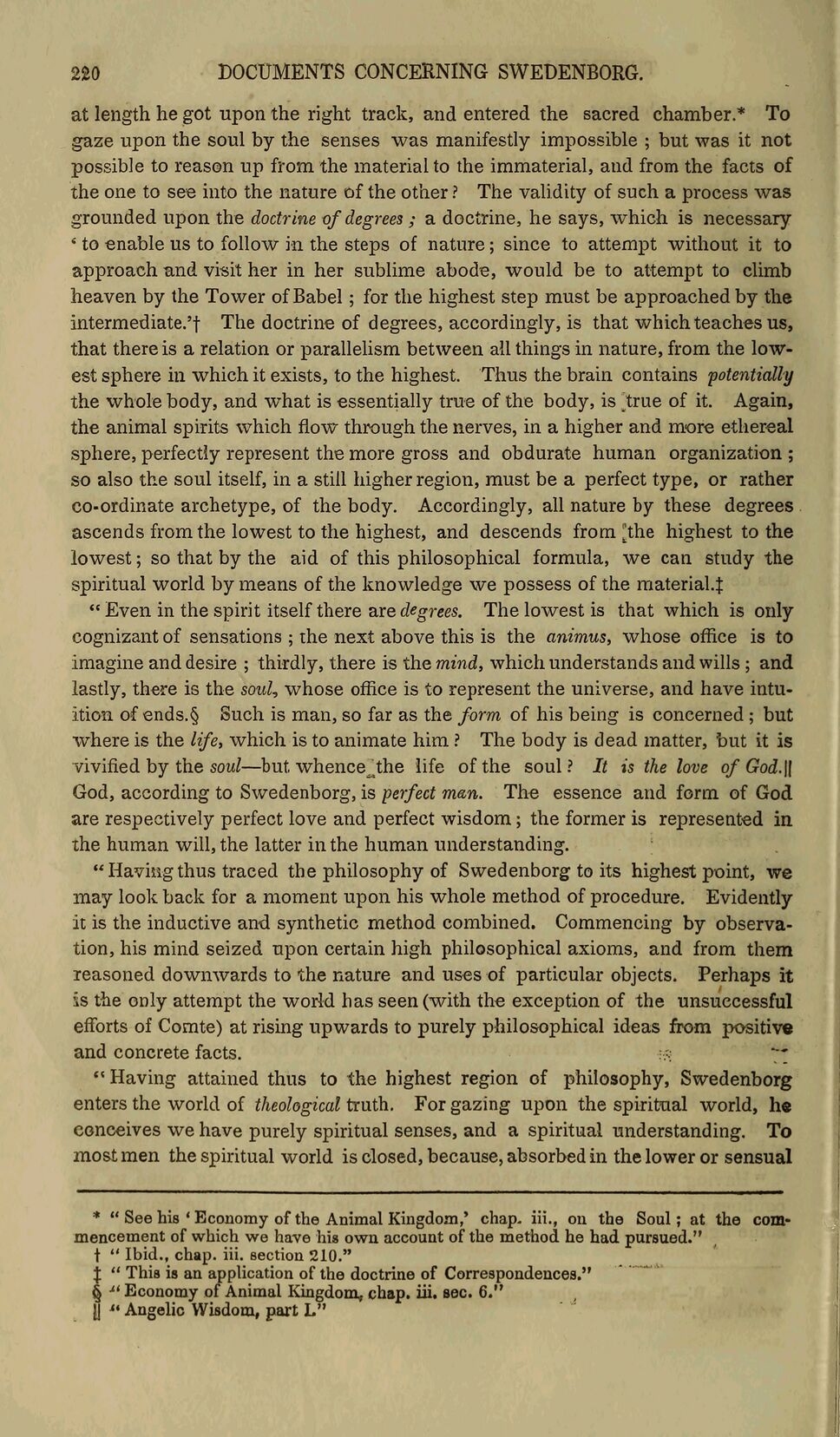
Full resolution (JPEG) - On this page / på denna sida - Sidor ...

<< prev. page << föreg. sida << >> nästa sida >> next page >>
Below is the raw OCR text
from the above scanned image.
Do you see an error? Proofread the page now!
Här nedan syns maskintolkade texten från faksimilbilden ovan.
Ser du något fel? Korrekturläs sidan nu!
This page has never been proofread. / Denna sida har aldrig korrekturlästs.
220 DOCUMENTS CONCERNING SWEDENBORG.
at length he got upon the right track, and entered the sacred chamber.* To
gaze upon the soul by the senses was manifestly impossible ; but was it not
possible to reason up from the material to the immaterial, and from the facts of
the one to see into the nature of the other ? The validity of such a process was
grounded upon the doctrine of degrees ; a doctrine, he says, which is necessary
’ to enable us to follow in the steps of nature ; since to attempt without it to
approach and visit her in her sublime abode, would be to attempt to climb
heaven by the Tower of Babel ; for the highest step must be approached by the
intermediate.’t The doctrine of degrees, accordingly, is that which teaches us,
that there is a relation or parallelism between all things in nature, from the low-
est sphere in which it exists, to the highest. Thus the brain contains ’potentially
the whole body, and what is essentially true of the body, is true of it. Again,
the animal spirits which flow through the nerves, in a higher and more ethereal
sphere, perfectly represent the more gross and obdurate human organization ;
so also the soul itself, in a still higher region, must be a perfect type, or rather
co-ordinate archetype, of the body. Accordingly, all nature by these degrees
ascends from the lowest to the highest, and descends from ^the highest to the
lowest ; so that by the aid of this philosophical formula, we can study the
spiritual world by means of the knowledge we possess of the material.^
" Even in the spirit itself there are degrees. The lowest is that which is only
cognizant of sensations ; ihe next above this is the animus, whose office is to
imagine and desire ; thirdly, there is the mind, which understands and wills ; and
lastly, there is the soul, whose office is to represent the universe, and have intu-
ition of ends.§ Such is man, so far as the form of his being is concerned ; but
where is the life, which is to animate him ? The body is dead matter, but it is
vivified by the 5om/—but whence^the life of the soul? It is the love of God.\\
God, according to Swedenborg, is perfect man. The essence and form of God
are respectively perfect love and perfect wisdom ; the former is represented in
the human will, the latter in the human understanding.
" Having thus traced the philosophy of Swedenborg to its highest point, we
may look back for a moment upon his whole method of procedure. Evidently
it is the inductive and synthetic method combined. Commencing by observa-
tion, his mind seized upon certain high philosophical axioms, and from them
reasoned downwards to the nature and uses of particular objects. Perhaps it
is the only attempt the world has seen (with the exception of the unsuccessful
efforts of Comte) at rising upwards to purely philosophical ideas from positive
and concrete facts. .; 7-^
*’ Having attained thus to the highest region of philosophy, Swedenborg
enters the world of theological truth. For gazing upon the spiritual world, h«
conceives we have purely spiritual senses, and a spiritual understanding. To
most men the spiritual world is closed, because, absorbed in the lower or sensual
* " See his ’Economy of the Animal Kingdom,* chap- iii., ou the Soul; at the com-
mencement of which we have his own account of the method he had pursued."
t " Ibid., chap. iii. section 210."
J
" This is an application of the doctrine of Correspondences."
’
§ " Economy of Animal Kingdom^ chap. iii. sec. 6."
jj
i* Angelic Wisdom, part L"
<< prev. page << föreg. sida << >> nästa sida >> next page >>